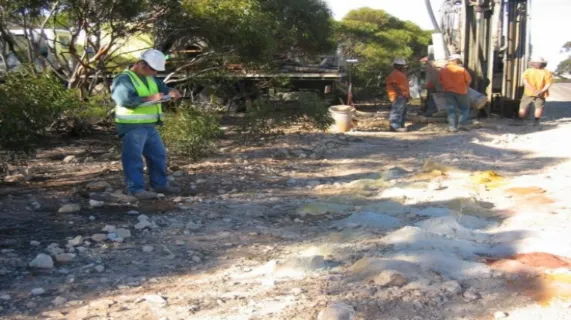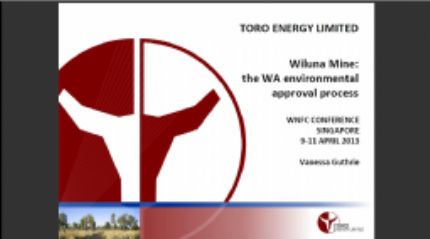
Toro Paleochannel Discovery
Adelaide, June 22, 2006 AEST (ABN Newswire) - A new palaeochannel containing anomalous uranium values has been identified in South Australia's far west by Toro Energy Limited (ASX: TOE).
Named the Kattata Palaeochannel, it was discovered in Toro's recently completed initial drilling campaign on its Yaninee Project area tenements covering 2733 square kilometres, 50 kilometres east of Streaky Bay (Refer Figure 1).
The drilling program identified anomalous uranium values over a 500 metre width across the channel (Traverse 5), with mineralisation remaining open to the east. Gamma logging returned peak responses of between 200 and 500 counts per second (cps).
One metre air core samples for assay compilation confirmed uranium presence, with results ranging from 10ppm to 66ppm U (or 12ppm to 78ppm U3O8 equivalent) across a 5 to 10 metre mineralisation zone thickness.
Anomalous uranium values ranging to 19ppm U (22ppm U3O8) were also confirmed in two traverses in the nearby known Yaninee palaeochannel, which contains some historic uranium values.
A total of 67 air core holes over seven traverses totalling 5,204 metres were completed during the program. Gamma logging of holes was undertaken during drilling, and samples of areas of interest were submitted for ICP or XRF analysis.
Compilation of the drill hole lithological data with the existing gravity and thermal imaging data is underway. Further work will most likely include:
- Additional infill drilling for more detailed sampling on Traverse 5
- Extension drilling to the east on Traverse 5
- Depending on results, additional traverses to the north and south will be planned
- Airborne EM surveys, linking with planned surveys of other Toro tenements, may be run over the Kattata palaeochannel
The Program
A network of palaeochannels crosses the Yaninee project tenements, including the southwesterly trending Venus Bay system, and the north-westerly trending Streaky Bay system (refer Figure 1). The area hosts a large number of Hiltaba Granite plutons, which are believed to be the source of the uranium values found within the palaeochannels.
Carpentaria Exploration Company Pty Ltd explored for sedimentary uranium throughout the region between 1979 and 1983, and discovered sub-economic uranium mineralisation in the western part of the channels.
Using a combination of the PIRSA PACE gravity data and Minotaur Exploration thermal imaging data, 10 potential traverses were planned. After further detailed microgravity surveys 7 traverses were selected for initial drilling.
Up to ten holes for each traverse were drilled to basement, with six traverses supporting the interpreted palaeochannel location and definition. One traverse encountered very hard layers and hence drilling to basement was difficult with the air core rig. Gamma logging of holes was undertaken during drilling, and samples of areas of interest were submitted for ICP or XRF analysis.
Results
This initial greenfield exploration produced two palaeochannels with defined anomalous uranium values, one being the Yaninee palaeochannel and one a new channel termed the Kattata palaeochannel (named after some old mine workings nearby). Anomalous uranium results were found in three of the seven traverses.
Traverse 5 located in the N-S trending Kattata palaeochannel, part of the Venus Bay system, was drilled on 150m spaced centres, with the last three holes indicating significant cps in the range 200 to 500 cps over various 1 - 3 metre intervals.
Initial composite samples of three to five metres showed anomalous uranium values up to 36ppm U (42ppm U3O8 equivalent), occurring within a 5 to 10 metre thickness zone. Subsequent one metre samples showed uranium results up to 66ppm U (78ppm U3O8 equivalent) - Refer Table 1. Additional infill holes were drilled which confirmed that the anomalous uranium extended over 500m of traverse length, and continues open ended to the east.
Traverse 8 and 10 tested the northward and southward extension to the Yaninee palaeochannel, with both traverses identifying anomalous uranium. Composite three to five metre samples showed assays ranging to 19ppm U (22ppm U3O8 equivalent).
Basement samples of the weathered Hiltaba granites in the base of holes of all traverses were assayed, and showed consistent anomalous uranium presence, confirming these rocks as the source of the palaeochannel uranium values.
The overall results are very encouraging, as they identify a new palaeochannel which hosts anomalous uranium values in the area, with both gamma and assay result confirmation. The results also again confirm the palaeochannel identification technique developed by Minotaur Exploration, now being used by Toro Energy, in being able to rapidly and cost effectively identify potential uranium hosting palaeochannel locations prior to drilling.
Table 1 - Assay Results for Traverse 5 - Hole 8------------------------------------ Depth Uranium U3O8ppm Thorium From To ppm equiv. ppm------------------------------------ 37 38 4 5 4 38 39 <4 <5 8 39 40 <4 <5 6 40 41 <4 <5 8 41 42 <4 <5 8 42 43 <4 <5 8 43 44 20 24 24 44 45 28 33 18 45 46 <4 <5 12 46 47 <4 <5 10 47 48 <4 <5 10 48 49 <4 <5 8 49 50 66 78 16 50 51 4 5 10 51 52 10 12 10 52 53 32 38 8------------------------------------Samples are 1 metre air-core compositesAssay by XRF - Amdel code XRF 1
Warrior Project
Planning is underway for a drill program on the Warrior project leases. The Toro Energy prospectus outlined the historical uranium occurrences in this area, and the work completed by Minotaur Exploration in 2005 to extend this mineralisation.
A drilling plan has been compiled and approved to complete infill drilling on existing traverses, and determine ideal location for new traverses to be drilled. An airborne EM survey is planned over this area, as well as over the tenements located in the Yellabinna Regional Reserve nearby. Estimated start date of this drilling is early July.
Ealbara Project
Early planning work has commenced to review historical information on the Ealbara project, located NE of the Warrior project. Airborne EM and potentially micro-gravity surveys to define palaeochannel locations will be undertaken in this area during the third quarter of this year.
The information in this report that relates to Exploration Results, Mineral Resources and Ore Reserves is based on information compiled by A. P. Belperio who is a Fellow of the Australasian Institute of Mining and Metallurgy. A. P. Belperio is employed by Minotaur Exploration Ltd, and acts as a geological consultant to Toro Energy Limited. Dr Belperio has more then five years relevant experience in the style of mineralisation and types of deposit under consideration and consents to inclusion of the information in this report and context in which it appears. He qualifies as a Competent Person as defined in the 2004 Edition of the "Australasian Code for reporting of Exploration Results, Mineral Resources and Ore Reserves".
Contact
Greg Hall
Managing Director
TEL: +61 8 8362 6677
Kevin Skinner
Senior Consultant
FIELD PUBLIC RELATIONS
231 South Road
MILE END SA 5031
Tel: (08) 8234 9555
Fax: (08) 8234 9566
Mob: 0414 822 631
kevin@fieldpr.com.au
| ||
|









